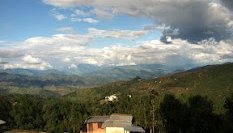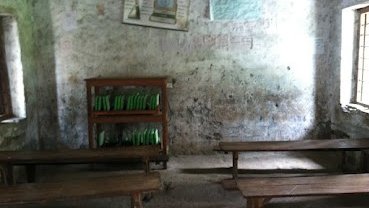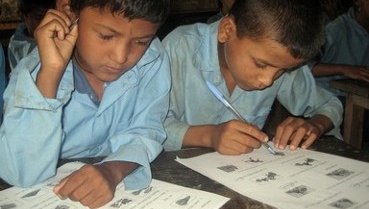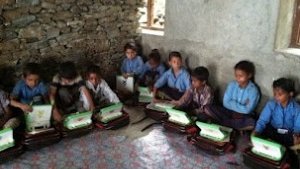A week into my internship at OLE Nepal, I was still the newbie struggling to remember everyone's names when I was asked if I wanted to go on the support/survey visit to Doti and Dadeldhura. Besides popping up on headlines now and then, the last time I had much interest in either of these places was when I was memorizing them for a social studies test a few years ago. I said, Yes.
Buddha Air's flight 951 to Dhangadi took off from Kathmandu on the 10th of July, and a little birdie called the newspaper warned me of the 37-degree weather that awaited an OLE Nepal team made up of (I am tempted to write sugar and spice and everything nice) Subir Sir, Niraj, Aman, and myself. With our backpacks and cables and monitors and toolboxes, we spiraled our way up the snaking road to Dadeldhura where four hours later, we reached Hotel Sunlight, perched on the appropriately named 'Toofan Dada'. The two teams split up the next morning as Niraj and Subir Sir were dropped off near Koral to start their own adventurous set of school visits that included having to eat raw mangoes off trees, a wild horse, and long muddy walks in the pouring rain.

Mauwa was a two-hour drive uphill from Dipayal on a muddy, winding road and after a quick lunch at the hotel, we headed to Mahadev Primary School about 20 minutes away. The schoolrooms were isolated from the rest of the world with bare walls and little or no furniture, save for the row of laptops (XOs) on charge in the corner. Students were in class on benches or on the floor, some older kids with younger brothers or sisters on their laps.

Chhaya Miss helped us to get the students organized for the baseline science survey. We selected 10 students each from grades 2, 3, 4, and 5 ranging from the top students to the students that weren't doing so well. We called them into classrooms, grade 2 and 4 in one and grades 3 and 5 in another while the rest were ushered into other classes. The younger students who couldn't yet read had difficulty understanding our different dialect of Nepali at this school so we quickly solicited the help of teachers to read out the questions. Besides having to remind them to not ask their friends for answers, the surveys went fairly smoothly. When some kids couldn't grasp the idea of circling the alphabet options, we accepted any mark that indicated the right answer. We also introduced ourselves and explained why we were there and gave the students candy, along with asking them if they brushed their teeth and kept their nails clean and took some pictures.
Afterwards, the children lined up for their daily serving of haluwa from UN WFP's School Feeding Program. Aman worked on the server as E-Pustakalaya hadn't been working (the problem turned out to be the loose RAM) as I updated the laptops. As we spoke with Chhaya Miss, we learned that there had been no electricity at the school until recently because of a thunderstorm and the month-long strike in the Far-West earlier this year meant that they hadn't had the chance to use the laptops much. When they were used though, the students were absorbed and took interest not only in the E-Paath specific to their grade but in all of them. Grade 5 students would spend time looking over grade 2 and using the ideas there in their writing. Something interesting she had noticed was that students were fighting a lot less with one another in school after they had started using the laptops.
The laptops were not being sent home during the monsoon. Five of them had screen problems and there were several broken chargers; Chhaya Miss guessed it was because they kept falling to the ground since the charging racks were loose. A few new students had enrolled in the school because they wanted to go to 'the school with the computers', while many also came for the food provided by WFP. However, though more students were coming to school, it also meant that classrooms were getting overcrowded and more difficult to manage for the already scarce number of teachers. An issue brought up by Chhaya Miss was that more students go from grade 1 to 2 than students that leave from grade 5. That past year, 8 students from grade 5 left behind laptops but 38 students were now in grade two, leaving 30 kids without laptops.
The hike to Bel from Mauwa involved walking into the fog down steep, rocky paths and narrow ledges on the edge of rice fields with a posse of mosquitoes following us at all times. Just another day in the life of an OLE Nepal intern! While asking for directions at every fork, for missing one would mean that we could end up on the seemingly identical--but wrong hill entirely, everyone wanted to know who we were and why we were there, if we were World Vision or if we were there to give trainings. I was accustomed to introducing myself as 'from Nepal' but that didn't cut it here. We were from 'Kathmandu', and therefore also foreigners. At 9 am with the sun already beating down on us, we knew we were at Durga Primary School as we were greeted by the singsong voices of children reciting numbers: nine one ninety-one, nine two ninety-two...
Here too, E-Pustakalaya wasn't working but was fixed fairly easily and the survey was run smoothly. Students of grade 2 struggled however, and were initially not responding to our attempt to communicate. Eventually, we ended up sitting with pairs of children and reading every question individually, and they seemed to do quite well. One question I distinctly remember a student answering after I read it out was: which option do you think is correct, only the mother working in the fields or both the mother and father working together in the fields? He circled the first option and smiled confidently. Perhaps the 'correct' answer was irrelevant when faced with his reality.

In Chasi, we stayed with Dhauli Miss in her home, and as we ate plenty of mangoes and papaya from the garden, she told us about the women’s troubles in the village whose husbands would get drunk and give them a hard time. Her own husband, whom she called a good man, was helping her chop vegetables and was sharing his own struggles from when he worked in Malaysia for four years and his current unemployment. At her home, we had the best Aam ko Achar, which we also brought back! The server at Saraswati Primary School couldn't be updated as the ports were not functioning, so Aman, or should I say Superaman, walked all the way back to Bel to attempt to update the hard drive using the server at the school there.
Saraswati school was a fifteen-minute walk uphill from Dhauli Miss’ home, made difficult by the rain. At the school, Dhauli Miss pointed out that those who didn't get picked for the survey might take it to heart—something that hadn't occurred to us. She devised a simple chit system to pick them so that the students saw they were chosen randomly rather than based on something personal.
The view from the school of the surrounding hills and the forests above it, resting on the clouds were picturesque. It was so serene and peaceful, like a little piece of some kind of paradise. But the truth for me, this was work in the form of a six-day adventure. For the people there, it was everyday life. The realities of our hills are harsh , and a pretty scene does not fill a hungry stomach or plow the fields or make it easier to get to the health post. The problems are numerous, difficult, intertwined, socially complex and largely political. Seeing laptop in these classrooms, though reaffirmed my faith that these phucche laptop and all that is done back there at the office, were going to do wonders, opening up a whole new world to these children.

Three and a half hours of some threateningly slippery rocks—thanks to the rain—and some down-a-hill-and-up-another-through-a-village-and-up-the-next-hill-and-down-another, later, we finally reached Dipayal. Elated to be back on a road wider than our shoulders, we were driven back to Dadeldhura, where later that night, we were reunited with the drained Subir Sir and nearly-collapsing Niraj, who had just returned from a long day of network cabling and updates at Samaijee Primary School in Haat.
We left early the next morning and drove down to Budar, and after leaving our things at the hotel, we drove to Hamtad, where Subir Sir and I went to Janajyoti Lower Secondary School while Niraj and Aman waded across the river to go to Selaling Primary School on the next hill.
At Janajyoti, the surveys were the easiest to conduct, and most students immediately grasped the questions. A thunderstorm had blown the roof off one of the buildings, and eight or ten laptops had gotten wet in the rain. The teachers, as soon as they realized what had happened, took out the batteries and put them to dry, after which they functioned normally.
We made our way back to Budar, and our driver Buddhi Dai rushed back in hopes that we would reach the hotel before the roads were obstructed by potential landslides. The next day, the flight back to Kathmandu was apparently quite eventful because of heavy turbulence and some shouting on the part of passengers (ahem, Niraj), but I say apparently because I, for one, was fast asleep.
Back at the office, I’m writing this blog and field visit logs, looking forward to some downtime in front of this trusty monitor! Over the last six days, we walked many paths, uphill, downhill, and winding, to make our way to each of these schools, but what was important was that these were steps in the right direction.